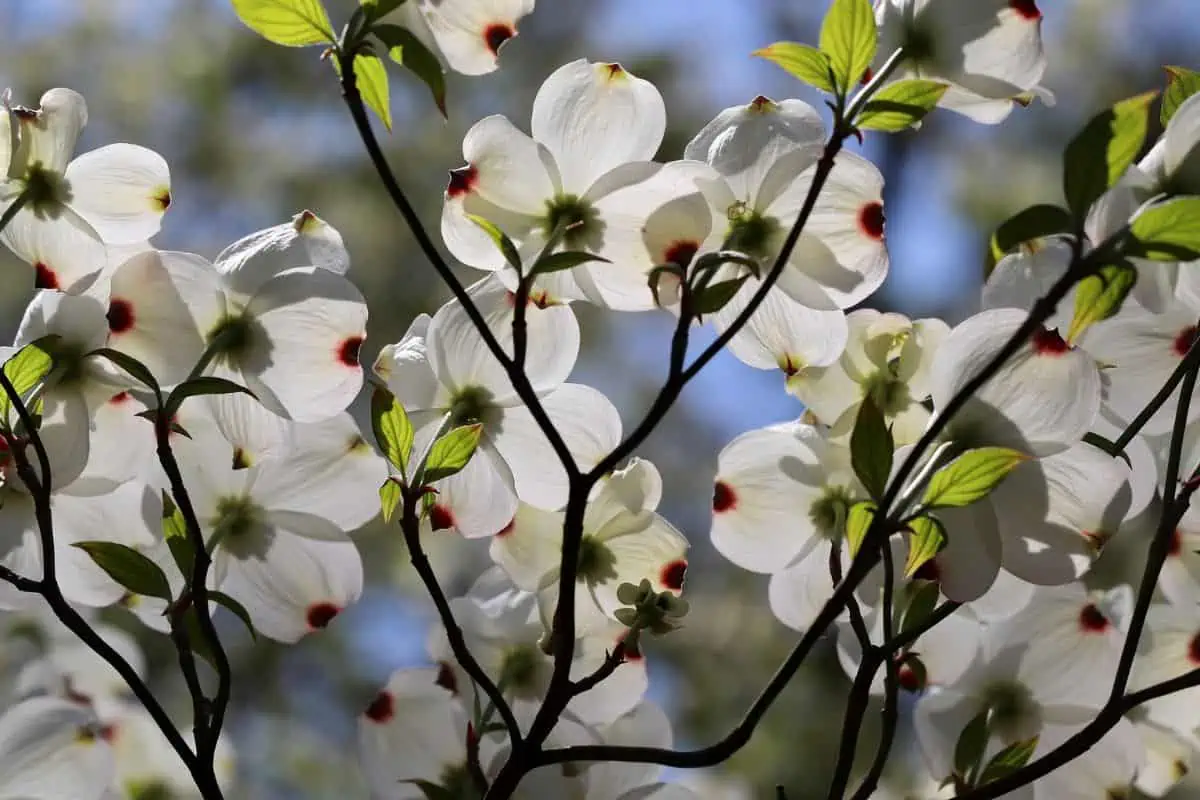Across the United States, a diverse array of flowering trees can be found, contributing to the beauty and ecological balance of the nation. Throughout the year, these trees adorn the landscape with their vibrant colors, providing visual interest to those who encounter them.
This article will explore a selection of notable flowering trees native to the United States, discussing their characteristics, geographical distribution, and ecological importance. A journey through the world of these fascinating trees will reveal their role in the rich tapestry of the nation’s flora and the countless ways they enhance the environment.
13 Flowering trees in the United States
The following list provides you with a snapshot of several remarkable flowering trees native to the United States, highlighting their unique characteristics and captivating beauty.
1. Dogwood
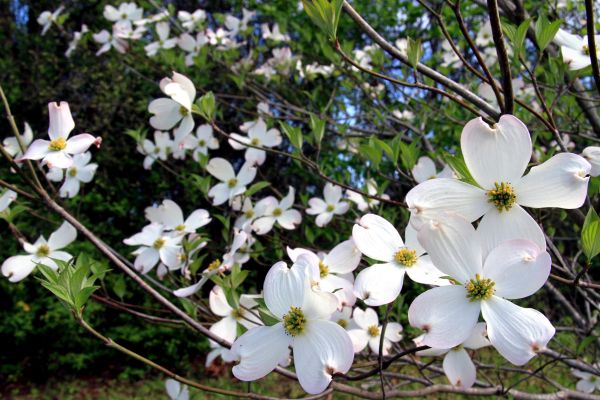
- Scientific name: Cornus florida
- Known species in US: 1
- When they bloom: April to May
The Dogwood tree is a deciduous tree that is native to the eastern United States. It is known for its stunning pink or white blooms that appear in the spring, typically between April and May.
The flowers themselves are actually bracts, or modified leaves, that surround the small true flowers. The bracts can be up to 3 inches in diameter, and they create a beautiful display against the tree’s dark green foliage.
Dogwood trees typically grow to be about 20-30 feet tall, though they can sometimes reach up to 40 feet. They have a rounded shape and a relatively short lifespan, usually only living for about 30 years. There is only one species of dogwood that is native to the United States, though there are several cultivars that have been developed for ornamental use.
While the blooms of the dogwood tree are certainly beautiful, it’s worth noting that they can be somewhat temperamental. In order to get the best display of blooms, the tree needs to be in the right growing conditions and free from stressors like drought or disease.
Additionally, some cultivars are more susceptible to disease or insect damage than others. Despite these caveats, the dogwood tree remains a beloved and iconic part of the eastern US landscape.
2. Redbud
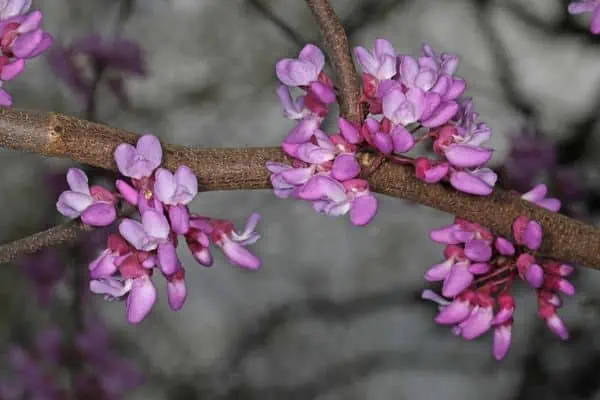
- Scientific name: Cercis canadensis
- Known species in US: 2
- When they bloom: February to April
The Redbud tree is a small to medium-sized deciduous tree that is native to the eastern United States. It produces small, pink or purple flowers in early spring, typically between February and April, before the leaves emerge. The flowers appear in clusters along the branches and trunk of the tree, creating a stunning display.
Redbud trees can grow to be up to 30 feet tall and have a rounded, spreading crown. They are relatively short-lived, typically only living for about 20 to 30 years.
There are two species of Redbud that are native to the United States: the Eastern Redbud and the Western Redbud. The Eastern Redbud is more commonly found in the eastern US, while the Western Redbud is found in the western US.
Redbud trees are popular in landscaping and are often used as specimen trees or in group plantings. They are relatively easy to grow and can tolerate a wide range of soil types and growing conditions. However, it’s worth noting that they can be susceptible to some diseases and insect pests, particularly if they are stressed or growing in poor conditions.
3. Yoshino Cherry
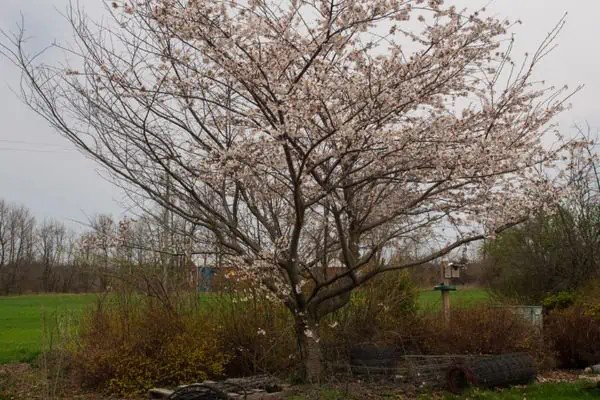
- Scientific name: Prunus x yedoensis
- Known species in US: 1
- When they bloom: March to April
The Yoshino Cherry is a small to medium-sized deciduous tree that is native to Japan. It is widely planted in the United States as an ornamental tree, particularly in Washington, D.C. where it is famous for its cherry blossom festival.
The tree produces showy, pink or white flowers in early spring, typically between March and April. The flowers appear in clusters along the branches of the tree, creating a stunning display.
Yoshino Cherry trees can grow to be up to 40 feet tall, though they are more commonly seen at around 20 to 30 feet in height. They have a vase-shaped crown and a relatively short lifespan, usually only living for about 20 to 30 years.
Yoshino Cherry trees are relatively easy to grow and can tolerate a wide range of soil types and growing conditions. However, they can be susceptible to some diseases and insect pests, particularly if they are stressed or growing in poor conditions.
4. Kwanzan Cherry
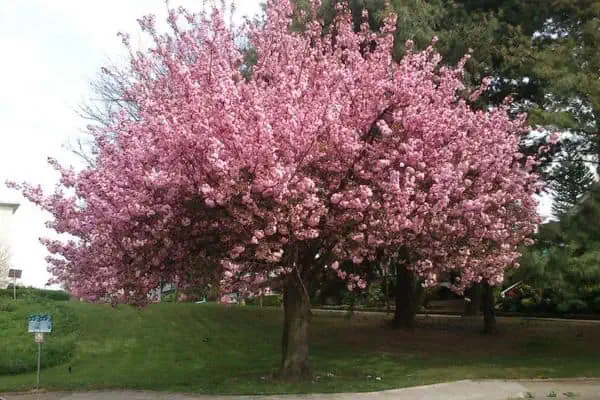
- Scientific name: Prunus serrulata
- Known species in US: 1
- When they bloom: April
The Kwanzan Cherry is a small to medium-sized deciduous tree that is native to Japan. It is widely planted in the United States as an ornamental tree, particularly in urban areas.
The tree produces showy, pink flowers in early spring, typically in April. The flowers appear in clusters along the branches of the tree, creating a stunning display.
Kwanzan Cherry trees can grow to be up to 30 feet tall and have a rounded, spreading crown. They are relatively short-lived, typically only living for about 15 to 25 years.
Kwanzan Cherry trees are relatively easy to grow and can tolerate a wide range of soil types and growing conditions. However, they can be susceptible to some diseases and insect pests, particularly if they are stressed or growing in poor conditions.
5. Magnolia
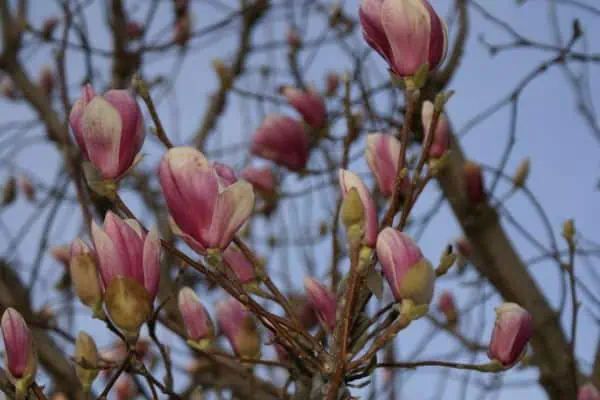
- Scientific name: Magnolia spp.
- Known species in US: Multiple
- When they bloom: Varies depending on species
Magnolias are a group of flowering trees and shrubs that are native to Asia and the Americas. There are many different species of Magnolia, and they vary widely in their appearance and bloom time. Some species bloom in early spring, while others bloom in late spring or summer.
Magnolias are known for their large, fragrant flowers, which can range in color from white to pink to purple. The flowers are typically cup-shaped or saucer-shaped, and they are often surrounded by a whorl of large, showy petals. Some species also produce cones or fruits that are highly ornamental.
Magnolias can vary widely in size, depending on the species. Some species are small shrubs, while others are large trees that can reach heights of up to 100 feet. They are typically grown for their ornamental value and are popular in landscaping and as specimen trees.
While Magnolias are generally easy to grow and care for, some species can be somewhat temperamental. They may require specific soil types or growing conditions in order to thrive, and some species are more susceptible to disease or insect damage than others. Additionally, the bloom time can vary depending on the species, so it’s important to research the specific needs of the Magnolia you are growing.
6. Tulip Poplar
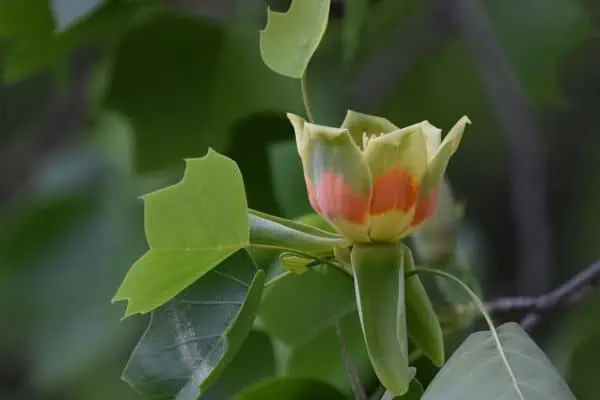
- Scientific name: Liriodendron tulipifera
- Known species in US: 1
- When they bloom: May to June
The Tulip Poplar is a large deciduous tree that is native to the eastern United States. It produces showy, tulip-shaped flowers in late spring or early summer, typically between May and June. The flowers are typically greenish-yellow in color with orange markings and are highly attractive to bees and other pollinators.
Tulip Poplar trees can grow to be up to 150 feet tall, though they are more commonly seen at around 70 to 90 feet in height. They have a straight trunk with a broad, pyramidal crown.
Tulip Poplar trees are relatively easy to grow and can tolerate a wide range of soil types and growing conditions. They are often used in landscaping and as a source of lumber for construction and woodworking. However, it’s worth noting that they can be susceptible to some diseases and insect pests, particularly if they are stressed or growing in poor conditions.
7. Crabapple
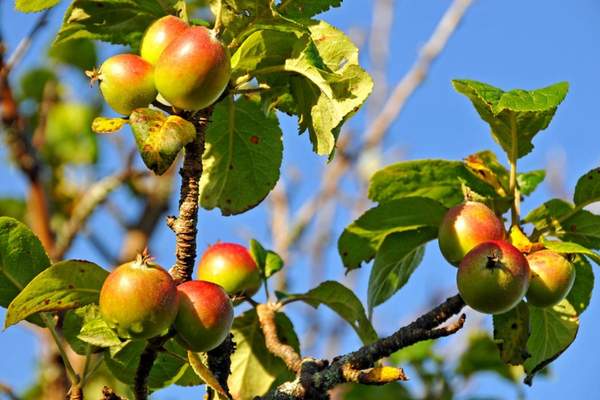
- Scientific name: Malus spp.
- Known species in US: Multiple
- When they bloom: March to April
Crabapples are a group of small to medium-sized deciduous trees that are native to the temperate regions of Asia, Europe, and North America. They are widely planted as ornamental trees, particularly for their showy, fragrant flowers that appear in early spring.
Crabapple flowers can range in color from white to pink to red, and they typically appear in clusters along the branches of the tree. The trees can also produce small, ornamental fruits that are highly attractive to wildlife.
Crabapple trees vary widely in size, depending on the species. Some species are small shrubs, while others are large trees that can reach heights of up to 30 feet. They are often used in landscaping and as specimen trees.
While Crabapple trees are generally easy to grow and care for, some species can be somewhat temperamental. They may require specific soil types or growing conditions in order to thrive, and some species are more susceptible to disease or insect damage than others. Additionally, the bloom time can vary depending on the species and the region of the country.
8. Black Cherry
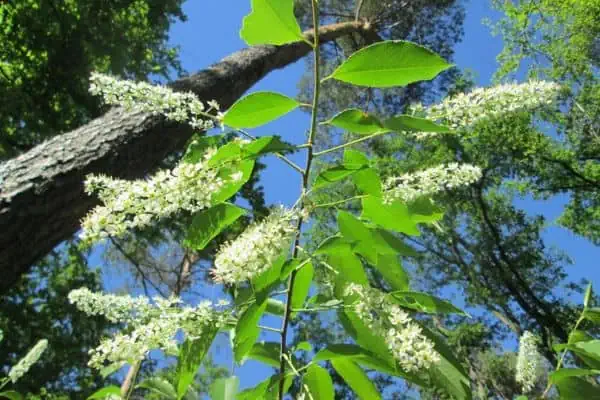
- Scientific name: Prunus serotina
- Known species in US: 1
- When they bloom: April to May
The Black Cherry tree is a deciduous tree that is native to the eastern United States. It produces clusters of small, fragrant white flowers in the spring that are followed by dark, edible berries in the summer. The tree can grow to be quite large, with a mature height of up to 80 feet and a trunk diameter of up to 3 feet. It has a narrow, conical crown and deeply furrowed bark.
Black Cherry trees are important ecologically, providing food and habitat for a wide range of wildlife. They are also commercially valuable, with the wood being used for furniture, cabinetry, and other purposes.
However, the tree can also be toxic to livestock and humans in certain situations. The leaves, twigs, and bark of the tree contain cyanide compounds that can cause poisoning if ingested in large enough quantities. For this reason, it is important to be cautious around Black Cherry trees and to keep livestock away from them.
9. Sourwood
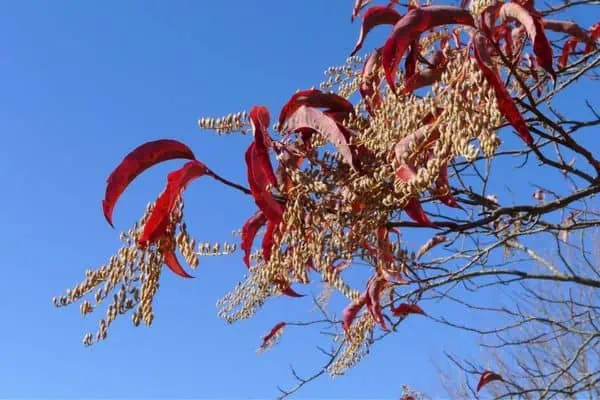
- Scientific name: Oxydendrum arboreum
- Known species in US: 1
- When they bloom: June to July
The Sourwood tree is a small to medium-sized tree that is native to the southeastern United States. It produces clusters of small, white, bell-shaped flowers in the summer that are highly attractive to bees and other pollinators. The tree has a narrow, upright crown and shiny, dark green leaves that turn red in the fall.
Sourwood trees are relatively slow-growing and can live for up to 100 years. They are prized for their ornamental value and are often used in landscaping and as a source of honey production. The tree’s wood is also used for making musical instruments and other items.
However, it is important to note that the tree can be difficult to transplant and may require special care to establish. Additionally, it is important to ensure that the tree is planted in the right growing conditions, as it is not tolerant of drought or pollution.
10. Fringe Tree
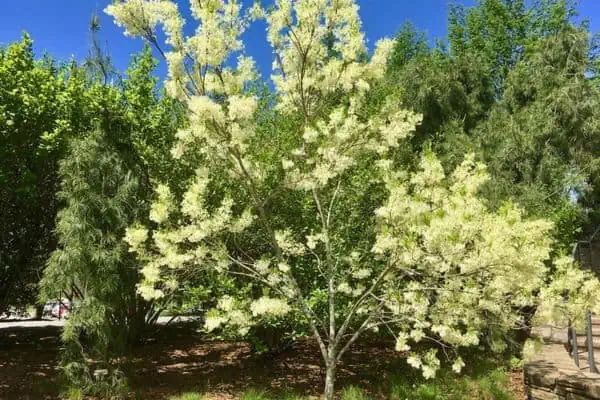
- Scientific name: Chionanthus virginicus
- Known species in US: 1
- When they bloom: May to June
The Fringe Tree is a small tree or large shrub that is native to the southeastern United States. It produces showy, fragrant, white flowers in late spring or early summer, typically between May and June. The flowers are long and narrow, with delicate, fringe-like petals that give the tree its name. The tree has a rounded crown and shiny, dark green leaves that turn yellow in the fall.
Fringe Trees are relatively easy to grow and care for, and they are popular in landscaping and as a source of ornamental value. They can grow to be up to 20 feet tall and are often used as specimen trees or in group plantings. The tree’s wood is also used for making tool handles, furniture, and other items.
While Fringe Trees are generally hardy and disease-resistant, it is important to ensure that they are planted in the right growing conditions. They prefer moist, well-drained soil and can be susceptible to drought or other stressors if not properly cared for. Additionally, the tree’s bloom time can vary depending on the climate and growing conditions, so it’s important to research the specific needs of the Fringe Tree you are growing.
11. Southern Magnolia
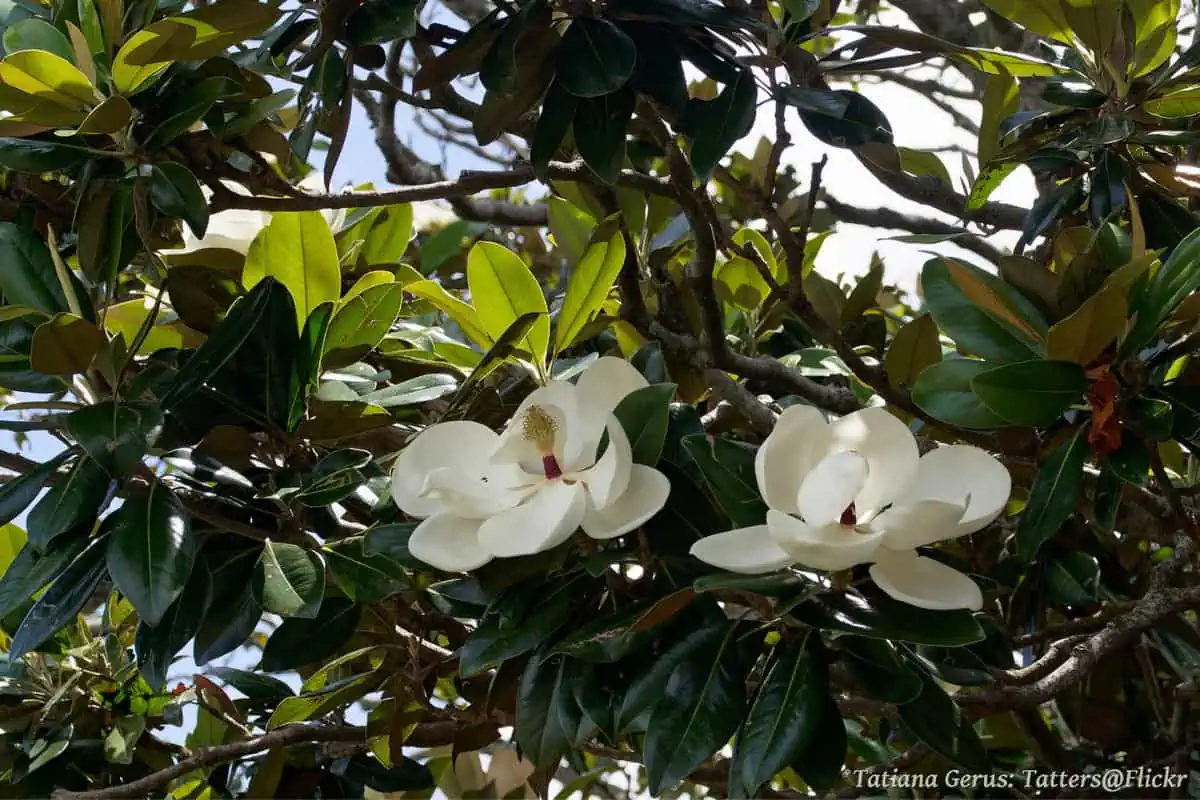
- Scientific name: Magnolia grandiflora
- Known species in US: 1
- When they bloom: May to June
The Southern Magnolia is a large evergreen tree that is native to the southeastern United States. It produces large, fragrant, white flowers in late spring or early summer, typically between May and June. The flowers are up to 12 inches in diameter and are highly attractive to bees and other pollinators. The tree has glossy, dark green leaves that are leathery to the touch.
Southern Magnolias can grow to be up to 80 feet tall and have a pyramidal shape with a wide base. They are often used in landscaping and as specimen trees, and their wood is highly valued for its strength and durability.
However, it’s worth noting that the tree can be somewhat temperamental, requiring specific soil types and growing conditions in order to thrive. Additionally, the tree can be susceptible to some diseases and insect pests, particularly if it is stressed or growing in poor conditions.
12. American Yellowwood
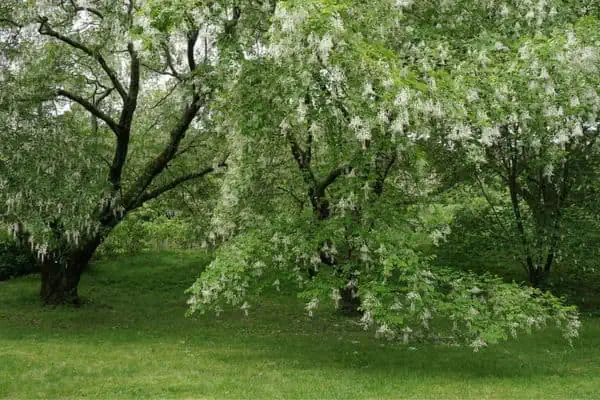
- Scientific name: Cladrastis kentukea
- Known species in US: 1
- When they bloom: May to June
The American Yellowwood is a medium-sized deciduous tree that is native to the southeastern United States. It produces clusters of fragrant, white flowers in late spring or early summer, typically between May and June. The flowers are highly attractive to bees and other pollinators. The tree has a rounded crown and smooth, gray bark.
American Yellowwood trees can grow to be up to 50 feet tall and are often used in landscaping and as specimen trees. They are relatively easy to grow and care for, and they can tolerate a wide range of soil types and growing conditions.
However, it’s worth noting that the tree can be somewhat slow-growing and may take several years to establish. Additionally, it can be susceptible to some diseases and insect pests, particularly if it is stressed or growing in poor conditions.
13. Eastern Red Cedar
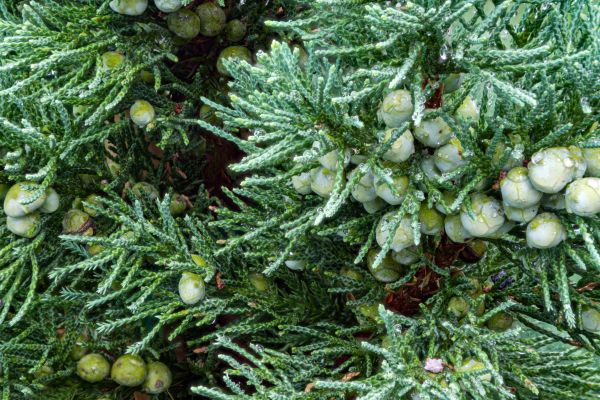
- Scientific name: Juniperus virginiana
- Known species in US: 1
- When they bloom: March to May
The Eastern Red Cedar is a small to medium-sized evergreen tree that is native to the eastern United States. It produces clusters of small, inconspicuous flowers in early spring, typically between March and May. The tree has grayish-brown bark and blue-green foliage that is highly aromatic.
Eastern Red Cedars can grow to be up to 60 feet tall and are often used in landscaping as a windbreak or privacy screen from neighbors. They are also commercially valuable, with the wood being used for fence posts, cedar chests, and other items.
Eastern Red Cedars are relatively easy to grow and care for, and they can tolerate a wide range of soil types and growing conditions. However, it’s worth noting that the tree can be somewhat invasive and may require some management to prevent it from spreading too widely. Additionally, the tree can be susceptible to some diseases and insect pests, particularly if it is stressed or growing in poor conditions.
Overall, these 15 blooming trees are just a small selection of the many beautiful and diverse trees that can be found throughout the United States. Whether you are looking for a showy ornamental tree for your landscaping or a source of valuable timber, there is sure to be a tree that meets your needs and preferences.
